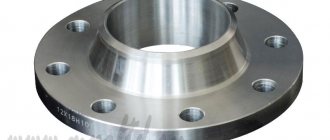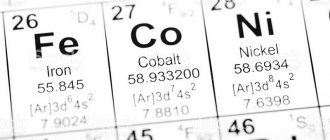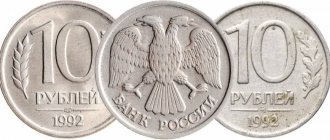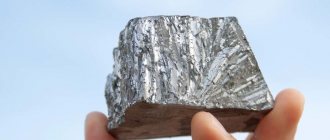Solving scientific and technical problems is often associated with the search for materials that have properties that natural materials do not have. Such progressive developments include precision alloys, in particular Invar.
Invar
Precision alloys mean those metal alloys that impart additional, predetermined properties to the selected base metal. Sometimes it is possible to obtain unique physical, chemical or mechanical properties. The final result is determined by the percentage of each metal in the alloy. The following metals are used to produce such alloys: iron, nickel, copper, cobalt and many others.
A very interesting group consists of precision alloys that have so-called anomalous properties. For example, their physical properties practically do not change, or change within small limits, when external influences change:
- ambient temperature;
- magnitudes and properties of magnetic and electric fields (amplitude, frequency, phase and polarization);
- increase or decrease in mechanical loads;
- exposure to reactive environments.
There are about twelve of the most commonly used similar alloys. The most common: invar (magnetic alloy of iron and nickel), elinvar, constantan, perminvar, manganin.
Invar got its name from the Latin word for “unchangeable.” It was created quite a long time ago - back in 1896 by the Swiss chemist and metallurgist Guillaume. However, the properties of this alloy were appreciated much later. The author himself received the Nobel Prize in Physics for this discovery. Developers of precision measuring equipment paid special attention to the physicochemical properties of invar.
Classification of iron-nickel alloys
Can be performed according to the following indicators:
- In terms of heat resistance. The predominant number of alloys under consideration have increased mechanical strength and resistance at high temperatures and external loads.
- According to magnetic characteristics. Some nickel-iron alloys have increased, compared to normal, values of their magnetic permeability.
- By its ability to maintain dimensional characteristics constant , as a result of which the expansion coefficient of alloys has stable values.
- According to anti-corrosion resistance , which is used in parts that work for a long time in aggressive environments.
In addition, it should be separately mentioned that some grades of cast iron are alloyed with nickel , which increases the durability of parts made from such material (for example, the rolls of large rolling mills are made of cast iron containing up to 3...4% nickel).
In the future, in a comparative analysis of the performance characteristics of iron and nickel alloys, only those alloys in which the percentage of nickel will not be less than 15...20 will be taken into account.
A significant number of grades of domestic iron-nickel alloys are produced according to industry specifications. However, in GOST 5732, along with heat-resistant and heat-resistant steels, iron and nickel alloys . In this case, the total percentage of these elements must be at least 65% , and the ratio of nickel to iron is set within 2:3 .
Paramagnets and ferromagnets
Let's consider the option when each atom of a substance has its own magnetic field. These fields are multidirectional and compensate each other. If you place a magnet next to such a substance, the fields will be oriented in one direction. The substance will have a magnetic field, a positive and a negative pole. Then the substance will be attracted to the magnet and can itself become magnetized, that is, it will attract other metal objects. For example, you can magnetize steel clips at home. Each one will have a negative and a positive pole, and you can even hang a whole chain of paper clips on a magnet. Such substances are called paramagnetic.
Ferromagnets are a small group of substances that are attracted to magnets and are easily magnetized even in a weak field.
Features of the composition
Dependence of the characteristics of the mechanical properties of the iron-nickel alloy KhN77TYUR on temperature
As a result of smelting, the structure of the alloys is a solid solution of y-iron in a nickel base. As a result of such dissolution, the stability temperature of the microstructure increases by 150...2000C. At the same time, up to 5000C, the diffusion of nickel into iron occurs very slowly, and is activated only when temperatures reach 700...8000C .
The main structural component is the intermetallic compound FeNi3, in which the nickel content, depending on temperature, is 55...75%. This predetermines the temperature range in which the heat treatment of such alloys is carried out. The highest percentage of nickel in stable alloys does not exceed 60...65% . The effect of introducing nickel into the main structure of the alloy is due to the fact that iron sharply increases thermal strength.
However, the presence of iron alone does not particularly improve the performance of iron-nickel alloys, especially those that require long-term resistance at elevated temperatures. chromium, tungsten, molybdenum, manganese and, in small quantities, silicon into the structure of iron-nickel alloys .
Thus, the main methods for obtaining the required structure of iron-nickel alloys are considered to be the mechanism of dispersion hardening, followed by heat treatment. It is produced in order to slightly increase the size of the grains in the structure and relieve internal stresses that are inevitable when some iron atoms are replaced by nickel atoms in the crystal lattice.
The fact is that nickel is corrosion resistant only in water vapor or in an atmosphere of pure oxygen (up to 9000C), and when additional sulfur or hydrogen is added there, the resistance drops to 5500C and 2800C, respectively.
Two concepts of magnetism
A common property of most magnetic substances is that their magnetism is due to atoms of so-called transition metals containing d-electrons (the subscript d refers to a certain type of symmetry of the electronic states of the atom). Transition metals are not only iron, cobalt and nickel, there are several dozen of them.
With the advent of the concept of electron spin and its corresponding magnetic moment, two different quantum mechanical pictures of magnetism were proposed - localized and band.
The localized picture formulated by Heisenberg assumed that electrons in a crystal do not jump from one atom to the next one, but there is an exchange interaction between electrons from neighboring atoms. This is a purely quantum effect, caused by the difference in the energies of parallel and antiparallel spin ordering. Stoner's band picture, on the contrary, implied the possibility of electron movement, and their interaction was mainly carried out within a single atom.
Diagram of the electronic configuration of an iron atom. Concentric circles correspond to different energy levels of the atom. Green dots represent electrons in s (circular) orbitals, blue dots in p (elongated) orbitals, orange dots in d orbitals with a more complex distribution in space
At first glance, the band picture seemed more applicable to transition metals. But it could not explain some phenomena, for example, the Curie-Weiss law, which describes the linear dependence of inverse susceptibility on temperature (susceptibility is the response of a system to a weak external magnetic field). At the same time, it was not at all obvious why the picture of localized electrons, which, as it seemed, could not be applied to transition metals (in particular, iron), described the experiment much better.
In the late 1950s and early 1960s, Neville Mott, followed by John Goodenough, proposed that some of the electrons in iron (namely, the electrons corresponding to the so-called eg states, two of the five possible d states on the atom) are characterized by “non-conducting wave functions”, that is, they do not jump, they are localized.
Although by that time the concept of the transition of electrons from a band, conducting state to a localized one had already arisen (thanks to the work of Mott), the Mott-Goodenough assumption was far beyond the boundaries of the then existing theoretical approaches. It corresponds to the so-called orbital-selective Mott transition, introduced much later.
Methods developed later (in the 1980s) for calculating exchange interactions in metals on the basis of band theory made it possible to obtain certain theoretical indications of the existence of localized moments in iron, but in the very method of these calculations, nevertheless, the conducting, band nature of electrons was inherent .
Peter Peregrin
(Petrus Peregrinus) - the 13th century French physicist Pierre Pelerin de Maricourt signed his works with this Latin pseudonym. The exact dates of his life are unknown. Peregrine is the author of the first experimental study and the first detailed scientific work on magnetism.
William Gilbert
(William Gilbert), 1544-1603 - English physicist and court physician, researcher of electricity and magnetism, author of the first theory of magnetic phenomena.
Properties and characteristics of heat-resistant alloys
Let's look at them using the most common brands as an example.
Alloy EP747 (or KhN45Yu) is used in metallurgy for the manufacture of roller tables along which ingots move. In addition to iron and nickel (nickel content 44...46%), it also contains chromium and aluminum . The alloy is smelted in electric furnaces, after which it undergoes hot plastic deformation, the temperature range of which is in the range of 1280...8500C (the first temperature is the beginning of deformation, the second is the end). The alloy lends itself well to heat treatment and electric arc welding. Assortment – sheets up to 2 mm thick and rods.
The physical and mechanical properties of the KhN45Yu alloy are:
- Mechanical strength – from 600 MPa at room temperatures, to 150 MPa at a temperature of 8000C;
- Heat resistance in still air – up to 1300...13500C;
- Oxidation intensity, g/m2∙h – no more than 170;
- Thermal conductivity coefficient at operating temperatures, W/m2 ∙K – 17.5…24.5;
- Young's modulus at operating temperatures, GPa – 12.5...17.5.
Alloy EI602 (or KhN75MBTYu) is used for internal lining of combustion chambers of metallurgical and thermal furnaces at temperatures not exceeding 900...9500C . In addition to iron and nickel , it also contains chromium, titanium, molybdenum, aluminum and niobium . Due to its more complex composition, which includes very heterogeneous chemical elements, after smelting in electric furnaces it is subjected to hot deformation in a much narrower temperature range: 1180...12800C. Unlike the previous alloy, KhN75MBTYu is more ductile, in particular, it allows deep drawing. hollow machine parts can be made from it , which will then be operated at high temperatures . Well welded by all types of electric welding .
Intensive formation of scale on the surface of this alloy begins only at temperatures from 1250...12800C. The alloy is supplied only in the form of sheets - hot or cold rolled.
The physical and mechanical properties of the KhN75MBTYu alloy are:
- Mechanical strength – from 860 MPa at room temperatures, to 177 MPa at a temperature of 9000C;
- Long-term strength and thermal endurance, MPa, not less than - 190;
- Thermal conductivity coefficient at operating temperatures, W/m2 ∙K – 20.2…19.3;
- Young's modulus at operating temperatures, GPa – 19.0...10.2.
Alloy EI868 (or KhN60VT) is distinguished by even higher heat resistance and resistance to exposure to aggressive environments . Therefore, it is used for the manufacture of gas turbine blades operating at temperatures of 950...10000C . The chemical composition of the alloy contains tungsten and chromium , and titanium .
Alloy range – sheets, rods and wires. The alloy has machinability and weldability characteristics similar to the KhN75MBTYu alloy, but is distinguished by higher heat resistance, the highest of the heat-resistant iron-nickel alloys: the oxidation intensity at operating temperatures of 10000C does not exceed 0.6...0.8 g/m2∙h. The structure and strength of the alloy do not change even after 30...35 heating and cooling cycles. The remaining physical and mechanical properties of the EI868 alloy are:
- Mechanical strength – from 800 MPa at room temperatures, to 43 MPa at a temperature of 10000C;
- Long-term strength and thermal endurance, MPa, no less - 210;
- Thermal conductivity coefficient at operating temperatures, W/m2 ∙K – 28…24;
- Young's modulus at operating temperatures, GPa – 19.0…2.0.
Distribution of paramagnets and diamagnets in the periodic table of Mendeleev elements
The magnetic properties of simple substances change periodically with increasing atomic number of the element.
Substances that are not attracted to magnets (diamagnets) are located mainly in short periods - 1, 2, 3. Which metals are not magnetic? These are lithium and beryllium, and sodium, magnesium and aluminum are already classified as paramagnetic.
Substances that are attracted to magnets (paramagnets) are located mainly in the long periods of the Mendeleev periodic system - 4, 5, 6, 7.
However, the last 8 elements in each long period are also diamagnetic.
In addition, three elements are distinguished - carbon, oxygen and tin, the magnetic properties of which are different for different allotropic modifications.
First steps towards a unified theory
The situation changed only in the late 1990s and early 2000s with the advent and development of the so-called dynamical mean field theory. This theory approximately reduces the complex problem of the movement of electrons in a crystal to the consideration of changes in their state over time on one selected atom. The theory made it possible to describe metal-insulator transitions in a number of substances, which naturally led to the question of its ability to explain the magnetism of transition metals.
Localized (top) and band (bottom) patterns of ferromagnetism
In particular, iron and nickel were studied within the framework of this theory by Mikhail Katsnelson, Alexander Lichtenstein together with the American physicist Gabriel Kotlyar in 2001.
They were the first to obtain, from a fully microscopic (i.e., first-principles equations) calculation within the band picture, a linear behavior of inverse susceptibility with temperature (Curie-Weiss law), which is usually interpreted as indicating the presence of local moments. They also found a weak dependence of local susceptibility on time (on the imaginary time axis, which is easier to study from a theoretical point of view), indicating the presence of local moments. At some point it seemed that the problem of iron and other transition metals was almost solved.
Sir Neville Francis Mott
(Nevill Francis Mott), 1905-1996 - English physicist, winner of the Nobel Prize in Physics in 1977, together with Philip Anderson and John van Vleck, “for fundamental theoretical studies of the electronic structure of magnetic and disordered systems”, author of the theory of interaction-induced transitions from metallic to insulating state.
John Goodenough
(John Goodenough), b. 1922 - American scientist, specialist in the field of physics and materials science.










